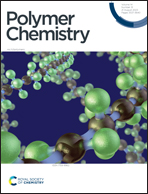Revealing the physical properties of chlorine-substituted poly(acetylene)†
Abstract
cis-3,4-Dichlorocyclobutene was synthesized and polymerized using the Grubbs 3rd generation catalyst. The corresponding ring-opening metathesis polymerization (ROMP) reaction proceeded in a controlled manner and provided access to narrowly dispersed polymers with tunable molecular weights. Treating poly(3,4-dichlorocyclobutene) with an organic base (e.g., triethylamine) prompted an elimination reaction and afforded poly(chloroethyne-ran-ethyne) in quantitative yield. The electrical conductivity of a film of the chlorine-substituted poly(acetylene) was measured and found to be comparable to values reported for organic semiconductors (10–5 Ω−1 cm−1). Higher conductivity (10–2 Ω−1 cm−1) values were achieved via p- or n-type doping. A block copolymer that featured a poly(norbornene) segment connected to a chlorine-substituted poly(acetylene) as well as a random copolymer derived from cis-3,4-dichlorocyclobutene and cis-2-ethylhexyl 4-chlorocyclobut-2-ene-1-carboxylate were also synthesized and studied. The copolymers displayed good solubility in organic solvents and valuable electronic properties. The polymers were characterized using various spectroscopic (NMR, FT-IR, UV-vis, XPS, and Raman) and thermal techniques as well as size exclusion chromatography (SEC).



 Please wait while we load your content...
Please wait while we load your content...